Vegans work to not consume or use animal products of any kind. Veganism can be thought of as a sort of extra-rigid subset of vegetarianism. Like many labels that we apply to groups of people, the words vegetarian or vegan illicit an immediate response or image for many people. Tell some folks you’re a vegan, and they may conjure in their minds an image of a “dirty hippie” with hemp curtains and a self-righteous air. Conversely, tell some vegans that you eat meat, and they may instantly have a Nugent-esque image of a rifle-rack in the rear window of your truck and blood dripping down your chin. It’s funny how that stuff works.
I am neither vegan nor vegetarian. I don’t have the disdain for these culinary and/or lifestyle choices that some folks do (I’m lookin’ at you, Bourdain), but on the other hand, I’ve long ago reconciled my love for animals with my interest in applying the least number of restrictions on what I will or will not eat. I believe these are choices that people must make for themselves and will leave it at that. Believe it or not, all of this is preamble for discussing the new cookbook I recently acquired.



The book is fantastic. I love the irreverent nature of the writing – it’s very personable and funny, and extremely accessible. And this cookbook encompasses a large breadth of material. The authors, Isa Chandra Moskowitz and Terry Hope Romero, begin with a discussion of basics – what to fill your pantry with, what tools you’ll need in your kitchen, how to prep and cook basic components and so on. They move on to a huge list of well-organized recipes, with relevant cooking tips sprinkled throughout. What I truly love is the fact that they’ve tagged their recipes with a variety of icons indicating such important information as whether the recipe can be prepared quickly, whether the ingredients are easy to find at the grocery store, whether or not the recipe should be considered low-fat, etc. It’s another step they’ve taken toward making vegan cooking accessible – it can be accomplished even without access to a specialty health-food store and without spending hours every day preparing the most basic of foods. The book includes a few pages of luscious-looking full-color pictures in the center to help push you over your apprehensions about vegan cooking being dull or lifeless. At the end, there are even menu suggestions, should you decide to go full-on vegan with any of your meals (or if you’re vegan and looking for some interesting variety).
And here’s an admission of guilt on my part. When I hear words like vegetarian or vegan, I instantly focus on what I’d have to give up if I made those choices. However, this cookbook has shown me that that is clearly the wrong approach. Take an ingredient that would normally be considered a side. The authors of Veganomicon often carefully consider these as main courses instead, imbuing them with their own interesting flavors and character. Such is the case with the first recipe I tried from the cookbook – Tamarind Lentils. Tiny French green lentils (my favorite) are given an extra dose of flavor by such goodies as garam masala, cayenne, cumin, and tamarind paste (among others). I served ours with a bit of couscous to soak up the yummy lentil liquid and, because I thought I might get a turned-up nose at a plate full of lentils, some marinated pork loin. The tamarind lentils were fantastic. The flavors were deep and spicy with subtle sweetness and wonderful balance. The couscous did a fine job of soaking up the cooking liquid, but I may try the leftovers with some basmati rice instead. Here’s the real clincher though. I explained to Sean, my husband, that the lentils were meant to be the main course and that I only served the pork to placate him. And … he agreed that the lentils would have been fine on their own … enthusiastically. He now even actually seems eager for me to cook something else from the book. If that’s not an endorsement, I don’t know what is.
I will be preparing more recipes from the book and letting you know how they turn out over the coming weeks. As it stands now, I am a fan. The book is well written, and truly the recipes look incredible. I will confess, I don’t much care for tempeh and tofu, and there’s a meat substitute in there called seitan that I don’t know that I could ever warm up to, but, for things that I might cook anyway – vegetables, legumes, grains – this cookbook seems to be a real gem. Don’t let the “vegan” label scare you away! Give this one some consideration.